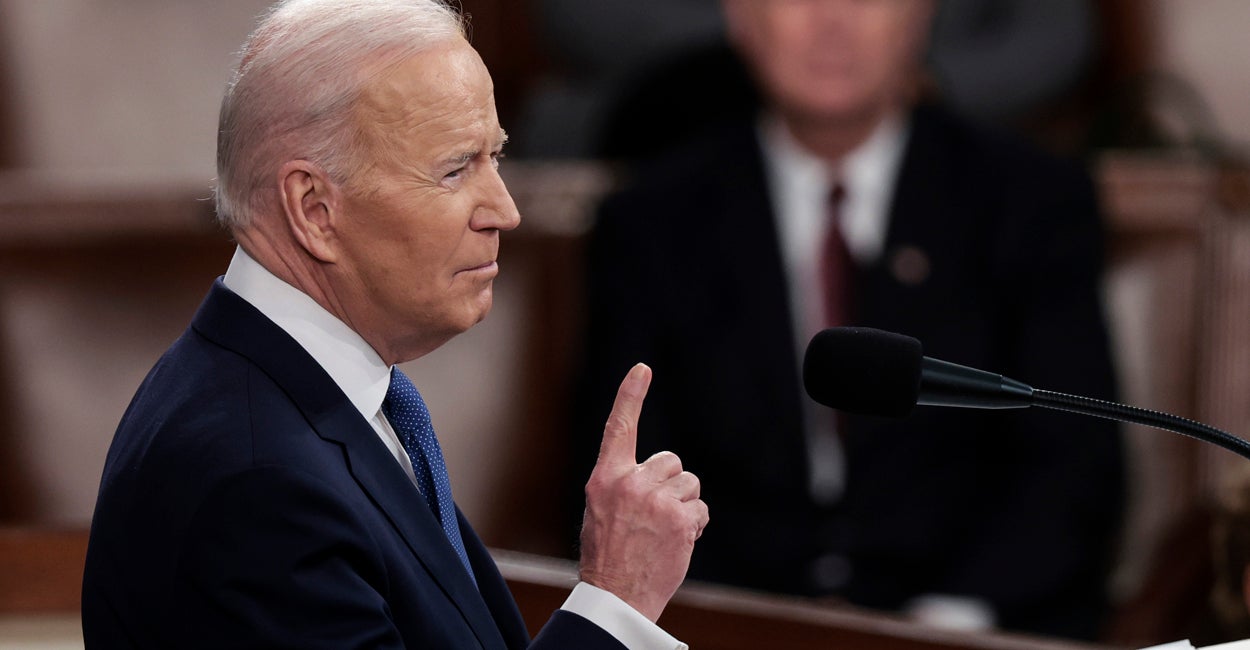In his first official State of the Union speech, President Joe Biden on Tuesday night addressed Russia’s invasion of Ukraine, rising inflation at home, an ongoing border crisis, and a fading COVID-19 pandemic.
Biden, who also spoke to a joint session of Congress last April, made numerous assertions of his administration’s successes in a speech that lasted just over an hour.
“My report is this: The state of the union is strong—because you, the American people, are strong,” Biden, who has been criticized as divisive, said at the end of his speech, adding:
The Daily Signal depends on the support of readers like you. Donate now
We are stronger today than we were a year ago. And we will be stronger a year from now than we are today. Now is our moment to meet and overcome the challenges of our time. And we will, as one people.
Here’s a fact check of 10 of the president’s contentions, which came as he continues to earn low job approval ratings from Americans.
1. ‘We Were Ready’ for Putin’s Invasion
Biden addressed the biggest issue in international politics—Russian President Vladimir Putin’s unfolding invasion of Ukraine, and the response from the United States and its allies.
“Throughout our history we’ve learned this lesson—when dictators do not pay a price for their aggression, they cause more chaos,” Biden said. “They keep moving. And the costs and threats to America and the world keep rising.”
He noted that the United States is a member of the 30-nation NATO military alliance.
“It matters. American diplomacy matters,” Biden said. “Putin’s war was premeditated and unprovoked. He rejected efforts at diplomacy. He thought the West and NATO wouldn’t respond. And, he thought he could divide us here at home. Putin was wrong. We were ready.”
How ready the Biden administration and allies were, however, is open to debate.
Russian troops have massed on the Ukrainian border since November. Ukrainian President Volodymyr Zelenskyy urged Biden to impose sanctions on Russia before an invasion could occur, as a preventive measure.
The Biden administration and European allies imposed sanctions on Russian financing a day after Putin’s full-scale invasion of Ukraine. However, several Republicans and Democrats agreed at the time that sanctions should be more severe.
Also, upon announcing the sanctions package, Biden said: “The sanctions we’ve imposed exceed SWIFT. The sanctions we imposed exceed anything that has ever been done.”
Two days later, however, European countries agreed to block Russia from SWIFT, the Society for Worldwide Interbank Financial Telecommunication, the primary international banking system. This move potentially could cut Russia out of global finance.
Under the Trump administration’s policies, the United States became a net exporter of oil starting in 2018, a development that boosted the nation’s energy independence.
The Biden administration increased green energy projects at the expense of fossil fuels and nuclear energy and added regulatory burdens on the oil and natural gas industry. By executive order, Biden shut down the Keystone XL pipeline project to move oil from Canada to the U.S. and he effectively greenlighted financing of Russia’s Nord Stream 2 pipeline to carry natural gas to Germany.
Upon Russia’s invasion of Ukraine, Biden and Germany reversed course on the Nord Stream 2 pipeline.
During his remarks Tuesday night, Biden said, “Tonight, I can announce that the United States has worked with 30 other countries to release 60 million barrels of oil from reserves around the world.”
However, half that amount, 30 million barrels, will come from the U.S.
2. State of the Economy, Job Market
Biden didn’t shy away from touting his accomplishments on the economy and job market as the nation began to emerge from the COVID-19 pandemic.
“In fact—our economy created over 6.5 million new jobs just last year, more jobs created in one year than ever before in the history of America,” Biden said. “Our economy grew at a rate of 5.7% last year, the strongest growth in nearly 40 years, the first step in bringing fundamental change to an economy that hasn’t worked for the working people of this nation for too long.”
The U.S. economy indeed added about 6.5 million jobs in the year that Biden has been president, the largest increase for a president in his first year in office.
However, this increase came in the wake of a wide-scale shutdown of the American economy during the pandemic. The total number of jobs is far below what it was under President Donald Trump in 2020, when the U.S. lost 9.5 million jobs.
Worse, the U.S. currently faces a serious labor shortage, with a near-record 11 million job openings.
“Job openings—currently at 10.9 million—are 40% above the pre-pandemic record, and more than double the prior 10-year average,” wrote Rachel Greszler, a labor expert at The Heritage Foundation, parent organization of The Daily Signal.
“Consequently, employers are struggling, with 49% of businesses reporting job openings that they’re unable to fill,” Greszler said.
And although the labor shortage has led to overall wage increases—5.7% over the past year—real wages have declined by about 2%, because of inflation and other factors.
“Employers have raised wages at about the fastest rate in 15 years, as they compete for talent amid record job openings and quit levels,” CNBC reported. “But consumer prices for goods and services are rising at their fastest annual pace in four decades, eroding those gains for many Americans.” During Biden’s presidency, inflation hit its highest level since 1982.
As for the manufacturing sector, Biden said: “All told, we created 369,000 new manufacturing jobs in America just last year.”
The president said he brought back manufacturing jobs. He said Ford and General Motors had created 11,000 and 4,000 jobs, respectively, saying it was evidence that manufacturing is returning.
But according to Heritage Foundation scholars, backed with data from the Bureau of Labor Statistics, about 179,000 more Americans were employed in manufacturing in 2021 than the previous year.
It’s possible that the Biden administration is counting vacant jobs in its calculations. Even with the increase in employment and the administration’s claims, though, the same Bureau of Labor Statistics data indicates that employment is not yet at pre-pandemic levels.
At one point, Biden also said: “Companies are choosing to build new factories here, when just a few years ago, they would have built them overseas.”
Heritage researchers have shown that the manufacturing industry is a vital part of the economy, and that the best way to bolster both manufacturing and the economy as a whole is to make America competitive.
Biden’s policies thus far have failed to make America competitive, they say, so any perceived benefits from returning manufacturing jobs will be limited. Additionally, purchasing American-made materials just because they were made in the USA is a poor decision, Heritage scholars say. They argue that American materials should be manufactured at home only if the U.S. has an advantage over other countries in producing those materials.
3. Solving the Border Crisis
Biden, widely criticized for allowing hundreds of thousands of illegal immigrants to cross the southern border during his first year in office, boasted of improvements there.
“At our border, we’ve installed new technology like cutting-edge scanners to better detect drug smuggling,” Biden said. “We’ve set up joint patrols with Mexico and Guatemala to catch more human traffickers.”
He added:
We’re putting in place dedicated immigration judges so families fleeing persecution and violence can have their cases heard faster. We’re securing commitments and supporting partners in South and Central America to host more refugees and secure their own borders.
Biden sought to be clear that he didn’t abandon the nation’s southern border. But, his actions during his first year as president—such as reversing Trump’s “remain in Mexico” policy and stopping construction of the border wall—haven’t shown positive results.
Illegal border crossings increased significantly. Biden administration officials initially said in early 2021 that this was a “seasonal” problem. But that flow turned into the highest surge in 21 years, according to The Wall Street Journal.
In 2021, U.S. Customs and Border Protection captured 1.95 million illegal immigrants on the southern border, compared to 511,192 in 2020 under the Trump administration, marking a 283% jump.
Fox News recently reported that Border Patrol agents encountered 153,941 illegal border-crossers in January, compared with 78,414 crossers in January 2021.
In January 2020, under the Trump administration, the number of illegal crossers was 36,585.
4. American Rescue Plan vs. 2017 Tax Cuts
Biden touted the American Rescue Plan, the $1.9 trillion spending bill he crafted with congressional Democrats in the name of COVID-19 relief.
“And unlike the $2 trillion tax cut passed in the previous administration that benefited the top 1% of Americans, the American Rescue Plan helped working people—and left no one behind,” he said.
The Tax Cuts and Jobs Act of 2017, supported by then-President Donald Trump and congressional Republicans, benefited all working Americans and not just the top 1%, many analysts say.
The Daily Signal reported that following passage of the bill, the labor market improved.
The tax cuts were largest for the lowest-income Americans and smallest for the top 1%, Heritage Foundation analysts noted. Heritage’s calculations also indicate that the top 1% paid more after passage of the bill than before.
The Daily Signal also reported that about 83,000 more Americans left their jobs for better options at the end of 2019, marking a surge in new job openings for the year after passage of the Trump tax cuts.
Heritage research shows that Biden’s American Rescue Plan hurt working people more than helped. One such pain point was a $15 federal minimum wage, which analysts warned would hurt the millions of small businesses struggling to stay afloat during the COVID-19 pandemic.
Heritage research also indicates that little of the funding went to helping Americans recover from the impact of COVID-19. Only 5% of the $1.9 trillion went to related relief.
As an example, nearly $90 billion was earmarked for a bailout of union pension plans, already underfunded before the pandemic. This union bailout gets about twice as much funding as COVID-19 testing and contact tracing, analysts said.
5. Assessing the Tax Burden
“Under my plan, nobody earning less than $400,000 a year will pay an additional penny in new taxes. Nobody,” Biden said.
This is incorrect.
Biden’s failed $4.6 trillion Build Back Better spending bill, which passed in the House of Representatives but met defeat in the Senate, would have increased taxes directly and indirectly for Americans who make less than $400,000 a year, analysts said.
The left-leaning Tax Policy Center said Biden’s plan would increase taxes on middle-income Americans.
“Taking into account all major tax provisions, roughly 20% to 30% of middle-income households would pay more in taxes in 2022,” the Tax Policy Center said, although it noted that these increases would be relatively small.
“Among those with a tax increase, low- and middle-income households would pay an additional $100 or less on average,” the center said. “Those making $200,000-$500,000 would pay an average of about $230 more.”
The Build Back Better spending bill proposed by Biden and congressional Democrats would have raised many other taxes. It would increase capital gains taxes and would increase the corporate tax rate to 26.5%, which indirectly decreases wages and increases consumer prices.
The plan also would raise nicotine taxes substantially. By many measures, these taxes would fall disproportionately on less affluent Americans.
6. ‘Lower Your Costs and Lower the Deficit’
Biden pitched a plan that he said would cut inflation and create jobs.
“One way to fight inflation is to drive down wages and make Americans poorer. I have a better plan to fight inflation,” Biden said, adding:
Lower your costs, not your wages. Make more cars and semiconductors in America. More infrastructure and innovation in America. More goods moving faster and cheaper in America. More jobs where you can earn a good living in America. And instead of relying on foreign supply chains—let’s make it in America.
Biden went on to say: “My plan to fight inflation will lower your costs and lower the deficit.”
It’s not known what the actual cost estimate for Biden’s proposals will be. His past promises don’t have a strong record.
Last year, the president failed to sell Democrats’ $4.6 trillion Build Back Better spending bill as not adding “a single penny” to the national debt or the annual budget deficit.
However, the Congressional Budget Office determined that Democrats’ spending bill would increase the deficit by $3 trillion from 2022 to 2031. The $1.2 trillion infrastructure spending bill, which passed earlier with some Republican support, will add $256 billion to the deficit, according to the CBO.
7. Fiscal Responsibility
Biden cast his administration as fiscally responsible.
“By the end of this year, the deficit will be down to less than half what it was before I took office,” Biden said, adding that he is the “only president ever to cut the deficit by more than $1 trillion in a single year.”
The budget deficit totaled $2.77 trillion for 2021, according to The Associated Press. That’s still the second-highest deficit on record after the $3.13 trillion the previous year, when Trump was still president.
“The deficits in both years reflect trillions of dollars in government spending to counteract the devastating effects of a global pandemic,” AP reported.
The budget deficit typically grows unusually high during a crisis, AP reported: “Before the deficit ballooned during two years of a global pandemic, the highest the biggest deficit had been a shortfall of $1.4 trillion in 2009 as the U.S. spent heavily to lift the country out of a severe recession following the 2008 financial crisis.”
The Congressional Budget Office projects that the deficit will fall to $1.15 trillion in the current budget year and dip below $1 trillion between 2023 and 2025. However, the CBO projects the deficit again will surpass $1 trillion a year from 2025 to 2031.
8. Rising Energy Costs
In his speech, Biden said he would “cut energy costs for families an average of $500 a year by combating climate change.”
One of the key ways he said he would attack inflation is by fighting climate change.
The president said Americans would save an average of $500 annually by joining together to combat climate change:
Let’s provide investments and tax credits to weatherize your homes and businesses to be energy efficient and you get a tax credit; double America’s clean energy production in solar, wind, and so much more; lower the price of electric vehicles, saving you another $80 a month because you’ll never have to pay at the gas pump again.
The most effective way to promote environmentally friendly innovation is through economic freedom, Anthony Kim, a Heritage Foundation research fellow and editor of Heritage’s Index of Economic Freedom, writes.
“Countries with greater economic freedom tend to fare better on protecting the environment than countries with more government-directed economies,” Kim says.
In 2020, America already had spent “more than $100 billion” on wind and solar energy, despite the fact that “less than 10% of our energy comes from the wind and the sun,” Stephen Moore, a former visiting fellow at Heritage, wrote in an energy and economics report.
Wind and solar power are “expensive, unreliable, and unscalable,” Moore said.
When it comes to electric cars, Forbes reports that an “electric vehicle may or may not save money, depending upon a host of factors, which will vary depending upon your location, driving habits, and choice of vehicle.”
With rising gas prices, electric vehicles may be looking more appealing to many Americans in 2022. In February 2021, the average price of gasoline was $2.50 a gallon, according to the U.S. Energy Information Administration. By last month, it had risen a full dollar to $3.50 per gallon.
Electric vehicle owners spend an average of 60% less on gasoline, CNBC reports. Using a commercial recharging station for an electric car costs anywhere between $11.50 and $45 per charge.
9. ‘Suppress’ and ‘Subvert’ the Vote
At one point in his address, Biden said: “The most fundamental right in America is the right to vote—and to have it counted. And it’s under assault. In state after state, new laws have been passed, not only to suppress the vote, but to subvert entire elections.”
The president called for the Senate to pass two federal election bills—the “Freedom to Vote Act” and the “John Lewis Voting Rights Act.” Conservatives oppose the bills as federal takeovers of elections long run by state or local governments.
Biden wasn’t specific about how new state laws would “suppress” voting or “subvert” the outcome.
A total of 19 states enacted new election reforms in 2021. The common themes of the laws were to expand voter ID requirements for mail-in ballots; curb the controversial practice of ballot harvesting that allows political operatives to collect and distribute large quantities of ballots and be present in a voter’s home when he or she votes; and require states to remove the names of dead voters and other ineligible voters from registration rolls.
Many states also banned private funding of election administration, in response to Facebook founder Mark Zuckerberg’s spending almost $400 million on funding election administration at the state and local level during 2020, primarily in Democrat-leaning jurisdictions.
As passed in 2021, Georgia’s new voting law—perhaps most criticized by Democrats—is demonstrably less restrictive than voting laws in Democrat-leaning states such as New York, Colorado, New Jersey, Wisconsin, Minnesota, and Rhode Island.
Notably, Delaware, the state Biden represented in the Senate from 1973 until 2009, will have early, in-person voting for the first time in the 2022 elections. The new Georgia voting law expanded early in-person voting.
10. LGBTQ Rights and Equality Act
Biden made a point of addressing Americans who aren’t heterosexual.
“And for our LGBTQ+ Americans,” he said, “let’s finally get the bipartisan Equality Act to my desk. The onslaught of state laws targeting transgender Americans and their families is wrong.”
“As I said last year, especially to our younger transgender Americans, I will always have your back as your president, so you can be yourself and reach your God-given potential,” he said.
Conservatives oppose congressional Democrats’ Equality Act, currently bogged down in the Senate in part because of concerns that it would restrict religious freedom. It takes 60 votes to suspend debate and move to a floor vote, but with the chamber’s 50-50 split between parties, the bill is unlikely to move forward.
The Equality Act “effectively denies the existence of biological sex, of women as such, replacing it with an amorphous and undetectable ‘gender identity,’” Jay Richards, a senior research fellow in The Heritage Foundation’s DeVos Center for Religion and Civil Society, tweeted Tuesday night.
Last year, 37 states introduced bills to prevent biological males who identify as women from competing on girls and women’s sports teams, and nine of these states passed such legislation.
“It used to not be controversial to observe that there are biological differences between boys and girls, and when it comes to athletics, there are, can be significant physical advantages for those who are born biologically male in terms of strength and size,” Sen. Ted Cruz, R-Texas, said during a Senate committee hearing in June.
Men have “larger hearts and lungs, more oxygenated blood, more fast-twitch muscle fiber, greater upper-body muscle mass, greater lower-body muscle mass, greater bone density,” writes Abigail Shrier, author of “Irreversible Damage: The Transgender Craze Seducing Our Daughters.”
“Even if a man later takes estrogen and artificially reduces the level of ‘bioactive’ testosterone in his body, he will not surrender these advantages,” Shrier writes.
Ken McIntyre contributed to this report, which was modified with additional details within three hours of publication. A section on border security, inadvertently deleted earlier, has been restored.
Have an opinion about this article? To sound off, please email letters@DailySignal.com and we’ll consider publishing your edited remarks in our regular “We Hear You” feature. Remember to include the URL or headline of the article plus your name and town and/or state.




























